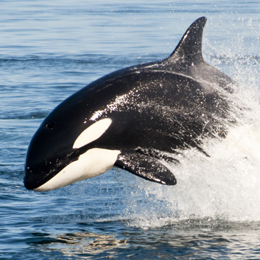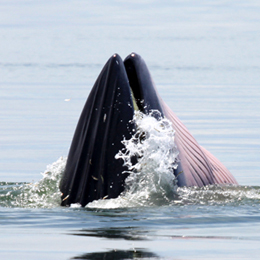Gentoo Penguin
The Pygoscelis papua, also known as Gentoo Penguin is found mainly in the Southern hemisphere between 45 and 65 degrees south latitude. Within this range, Gentoo penguins inhabit the Antarctic Peninsula along with numerous sub-Antarctic islands. The scientific description of P. papua was first made by the German naturalist Johann Reinhold Forster in 1781 who accompanied Captain James Cook on his second Pacific voyage. Although the origin of the word ‘gentoo’ is still unclear, it is thought to have been derived from the Portuguese word ‘gentil’.
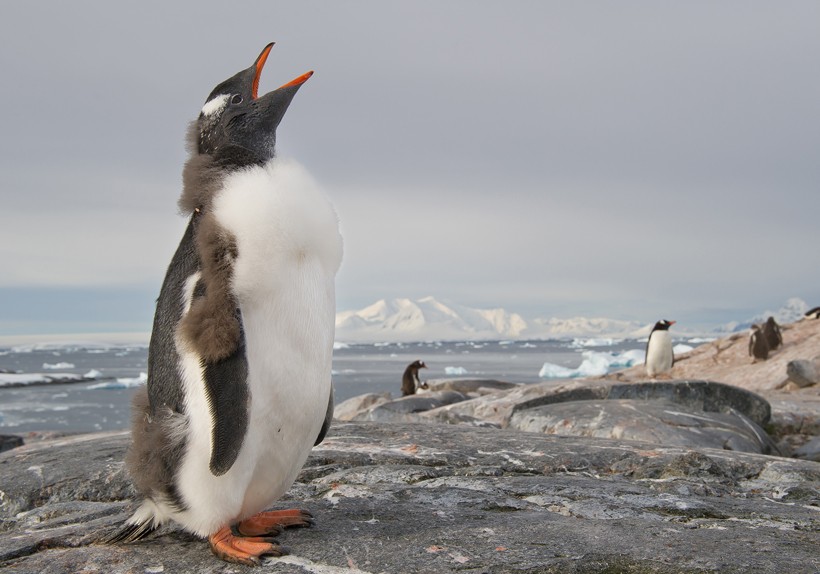
Juvenile Gentoo Penguin calling on rocky beach, Antarctic Peninsula
?
Image credits: MZPHOTO.CZ/Shutterstock
The average height of Gentoo Penguins is 80 cm and its average weight is around 5 kg. They can be easily recognized due to their bright reddish-orange bill, the white stripe over their head resembling the shape of a bonnet, the pale white webbed feet with a tinge of pink and the prominently long tail. Both males and females have similar markings but the females are usually smaller in size. The average lifespan of this flightless bird is 13 years.
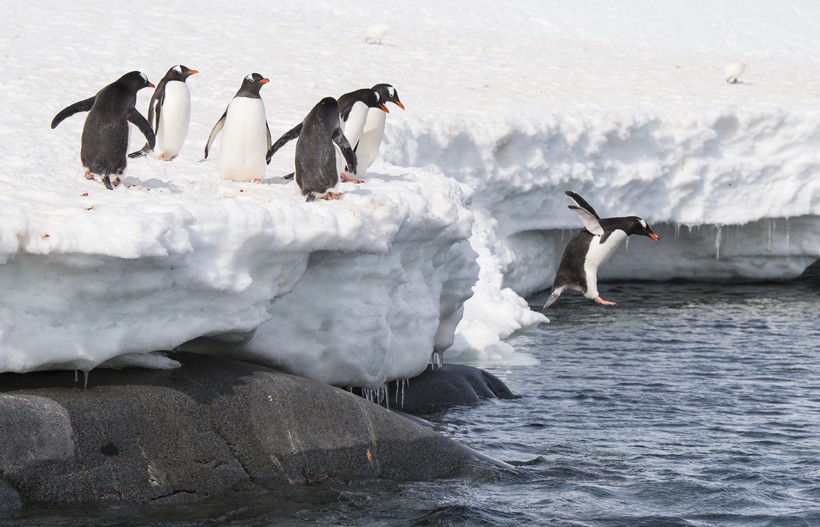
Gentoo Penguins jump from the ice
?
Image credits: vladsilver/Shutterstock
Moreover, these long-tailed penguins are the fastest underwater swimmers with their top speed being 36 km/hr (22 mph) which also make them an efficient hunter.
Along with the speed, the Gentoos have an excellent underwater vision but this quality gets impaired once they step on land. Their special retinas become very sensitive in contact with water which allows them to distinguish between the colors blue, purple and green while swimming underwater.
Subspecies
The two known subspecies of Gentoo Penguins are Pygoscelis papua papua and Pygoscelis papua ellsworthii, a subspecies that is somewhat smaller in size than its former relative. Besides the subspecies, this bird is a close relative to Adelie Penguin and the Chinstrap Penguin as both of these penguins share the same genus Pygoscelis to which the Gentoo belongs. Contrary to the predominantly gentle and laid-back Gentoo Penguins, the Adelie and Chinstrap penguins are more aggressive and raucous by nature.
Anatomy and Characteristics
The height of Gentoo Penguins varies from 51 to 90 cm (20 – 35 in) which places them third in the category of penguin sizes. Males of this species can weigh a maximum of 8.5 kg (19 lbs), a weight that is attained before molting. However, before mating they can weight as less as 4.9 kg (11 lb). Females, on the other hand, show a maximum weight of 8.2 kg (18 lbs) right before molting and a minimum of 4.5 kg (9.9 lbs) during the period when they are involved in taking care of their chicks.
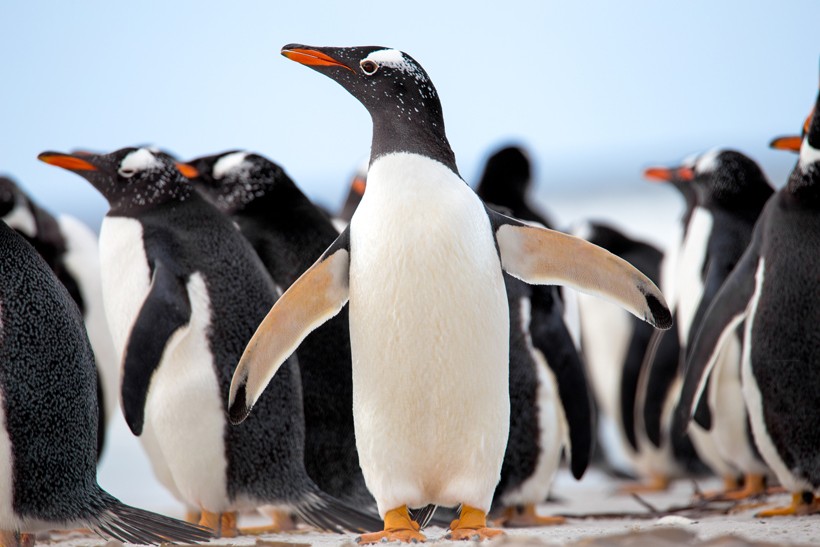
Gentoo Penguins at the Falkland Islands
?
Image credits: fieldwork/Shutterstock
Similar to other penguin species, Gentoo Penguins have a white colored ventral and black dorsal side. This color pattern, also known as countershading, is a very useful adaptation mechanism for the penguins when they swim underwater. The white ventral side blends in perfectly with the sky (while looking from the ocean floor) due to which their prey remains oblivious to their presence while the black dorsal side harmonizes with the dark color of the ocean floor thereby making them almost invisible to their predators.
Gentoo Penguins have unique head markings which distinguish them from other penguin species. Their eyes are surrounded by two white wedges which are connected with each other by extension over their heads with a medium-sized white line. A major portion of their head is covered by black feathers but white feathers can also be found in small flecks.
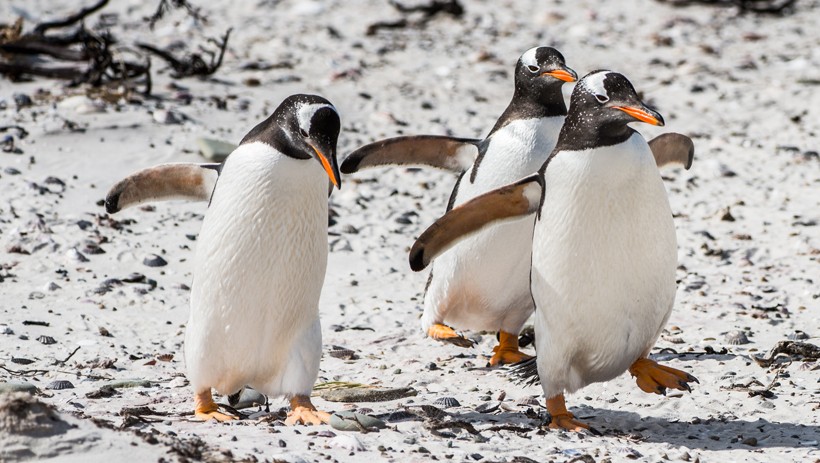
Gentoo Penguins walking on the beach
?
Image credits: Anton_Ivanov/Shutterstock
The Gentoos have very fine feathers which cover their entire body. They have a very distinguishing tail that contains up to 18 feathers with each of them being almost 15cm long. Because of their marine habitat, it is important for the Gentoos to keep their feathers waterproof as much as possible. They do so with the help of a special oil secreted by their uropygial gland located at the base of their long feathery tail. Using their bills, they extract this oil and rub it over their feathers thereby making themselves waterproof.
Regarding their physical features, Gentoo Penguins have fat, stout and webbed feet that can be either whitish-pink or bright orange in color with long back claws. The beak is partially black and spotted with bright reddish-orange color on either side. This bright color is formed due to the presence of carotenoids which they absorb by eating krills.
Habitat
The shorelines along the Antarctic Peninsula and sub-Antarctic islands are the typical habitats of the Gentoo Penguins. This habitat makes it convenient for the penguins to access food easily as well as stay in range of their nest sites. Along the shorelines, these penguins choose to build their nests at elevations of more than 100 m above sea level to prevent potential problems because of snow melting; this higher altitude decreases the possibility of nest flooding due to the snow meltdown during summer.
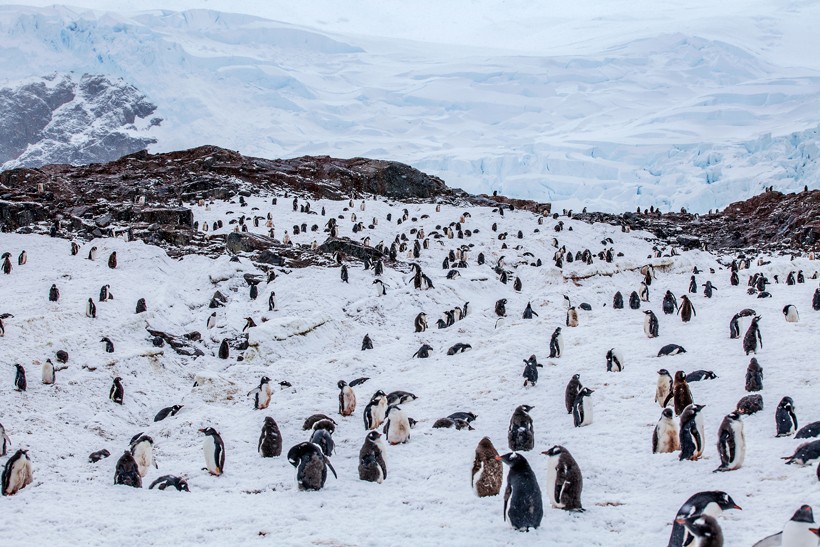
Large colony of Gentoo Penguins
?
Image credits: sichkarenko.com/Shutterstock
Moreover, these areas have a flat terrain which provides good stability for their nests which they typically build on the ground. For nesting, these long-tailed penguins prefer the north-facing locations mainly in order to absorb a greater amount of solar radiation. They make rudimentary nests using stones, pebbles, sticks, feathers or any other material that they might find suitable for placing around their nest. However, the pebbles act as the main building block which provides enough strength to their nest for holding their eggs during the breeding season.
Diet, Hunting and Predation
Diet
As being a carnivore, the Gentoo Penguins’ diet mainly involves fish, cephalopods and crustaceans. Depending on the season, they prey on different animals in different percentages. Although most of their crustacean diet is made up by krills and shrimps in the months of February and March, these crustaceans only cover 10% of their usual diet. This 10 % jumps to 75 % from March until June. The rest of the time, the crustaceans remain absent from their everyday diet. On the other hand, in the period between June and October, 90 % of the penguins’ diet involves the rockcod (Lepidonotothen squamifrons) while the remaining 10 % might involve unicorn icefish (Channichthys rhinoceratus).
Hunting
Gentoo Penguins generally feed in the shallow regions and are seldom seen foraging in deeper waters. As fast swimmers, they can easily chase down their smaller prey and catch them in a matter of seconds. When the Gentoo's are underwater, the metabolic rate of their body automatically slows down allowing them to forage underwater for longer periods of time.
Predation
The young chicks of gentoo penguins are more vulnerable to predation. The Brown skua (Catharacta lonnbergi) is the most prominent predator of these chicks who are perceived as solitary and weak. Apart from this aerial predator of Gentoo chicks, the adult Gentoo Penguins gets predated in water by leopard seals, Weddell seals, sea lions and killer whales. The leopard seals seem to prefer Gentoos so much that they would often travel to their breeding ground and hunt them down. Additionally, sea lions and killer whales predate on the young penguins that enter the water for the first time during fledging and still being in the process of learning how to swim as fast as their parents.
Reproduction and Life cycle
The choice of mate among the female Gentoo Penguins depends on the male’s behavior. As a starter for attracting females, the males find one of the best spots for making their nest. They would generally choose those areas that are particularly flat and free from snow as much as possible. Once they have chosen their nest site, the male Gentoos would bellow out calls by pointing their bills upward in the air. This call is like an invitation for females to visit and investigate the newly chosen nest site. In response to the call, if a female penguin waddles by and approved the nest, both male and female starts to display their approval by bowing or trumpeting.
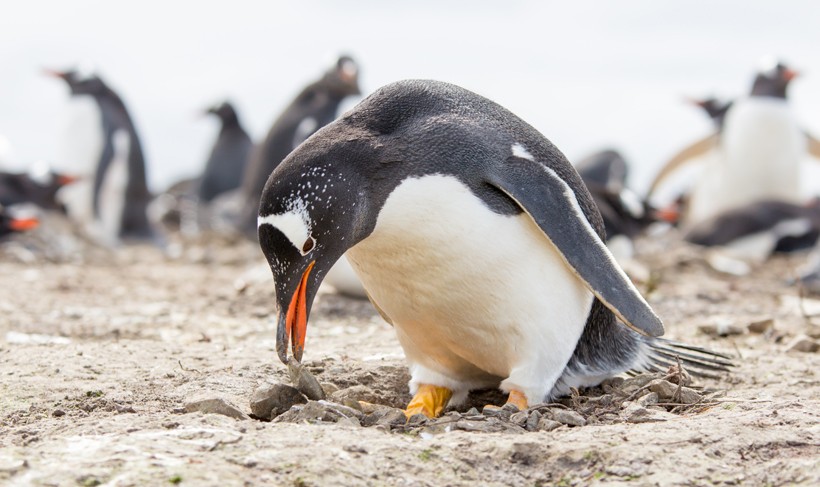
Gentoo penguin building it's nest by carefully placing rocks and twigs with it's beak. Falkland Islands.
?
Image credits: fieldwork/Shutterstock
During the breeding season, Gentoo Penguins remain monogamous while some pairs even make their bonds for lifetime. Although there are occurrences of females choosing new partners based on potential reproductive success within the same breeding season, the monogamous penguins appear to have a better reproduction rate. The reason is that in a monogamous relationship the male and female are no longer obliged to invest their time in finding new partners each year and hence become advanced in reproducing and bringing up their young ones.
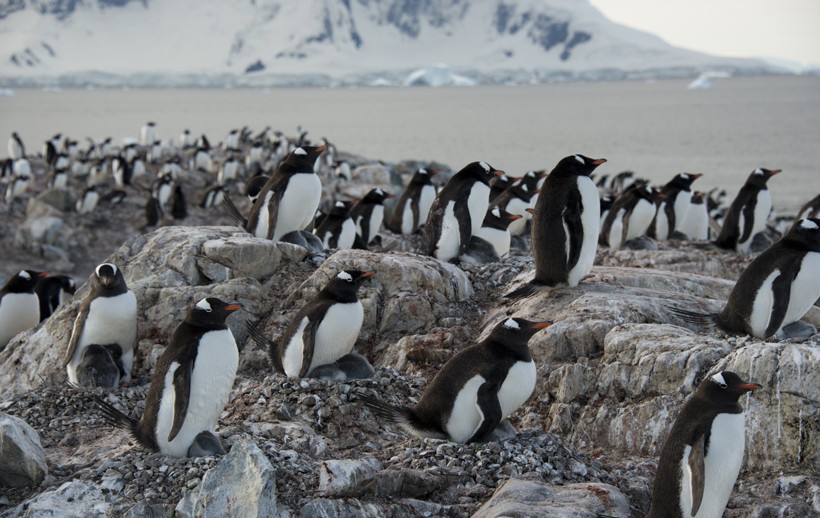
Gentoo Penguins nesting at Ronge Island
?
Image credits: Petra Christen/Shutterstock
Female Gentoo Penguins attain sexual maturity around the age of two but most of them do not start breeding until they become three or four years old. On average, the eggs are laid between June and mid-August while the breeding season lasts until late November. This species of penguins usually lay two eggs in every breeding season: the first egg is laid after about 5 days since the beginning of their copulation and three days later the second egg appears. The eggs are greenish-white in color and their shape is spherical. The average weight of an egg is 125 grams and depending on the nesting location there may appear slight variations in weight between their first and second egg.
The female Gentoo Penguins are capable of laying another set of eggs in the same breeding season if the first set gets lost or eaten by predators. This second set is laid by the end of their breeding season and allows the females to regain sufficient energy to lay eggs for the second time. However, laying eggs at the last moment renders them weak, which in turn delays their molting. As Gentoos undergo molting right after the breeding season, a delay in molting in one season results in delayed egg-laying in the next year. In fact, most of the females who lay two sets of eggs in one breeding season often lack the sufficient energy for laying a clutch the following year, thereby missing one entire breeding season.
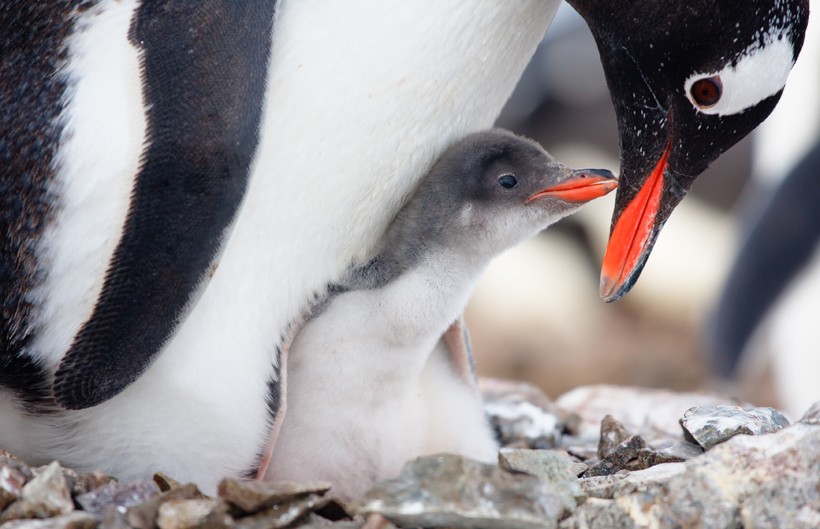
Gentoo Penguin in nest with chick
?
Image credits: Volodymyr Goinyk/Shutterstock
The average period of incubation is 35 days which is shared by both parents. Even though the eggs are not laid on the same day, the newborn chicks usually hatch on the same day. Right after hatching, the chicks weigh only 96 grams and remain very frail. Both male and female take care of the chicks equally. They defend their nest from predators that might come too close to their nest by hissing and sticking out their bill.
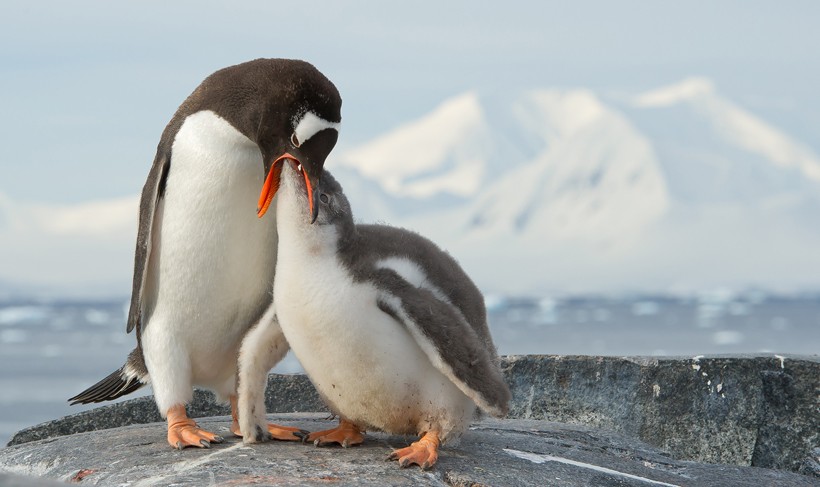
Gentoo penguin feeding chick on rocky beach, Antarctic Peninsula
?
Image credits: MZPHOTO.CZ/Shutterstock
For the first few weeks when the chicks stay in the nest, both parents regularly take turns for getting food for their young ones. Like other species of penguins, the Gentoos also feed their young ones with regurgitated fishy paste. After about four weeks, the chicks start moving short distances and form groups with chicks of other nests. This helps them to defend against predators and allows the parents to bring more food for the fast growing young ones by foraging together. After about 70 days, the chicks become ready for fledging and start to visit the ocean. These young ones attain complete independence after about 20 days of fledging.
Behavior, Communication and Intelligence
Gentoo Penguins exhibit an extremely territorial nature regarding their nests. Except the area around their nest which can be an average of one square meter, the Gentoos haven’t been seen defending any other territory. They live in colonies and a single colony of Gentoo Penguins can contain up to 2000 breeding pairs. With such a large number on one site, it is common for them to build their nests at only a meter apart from another and indulge in territorial fights.
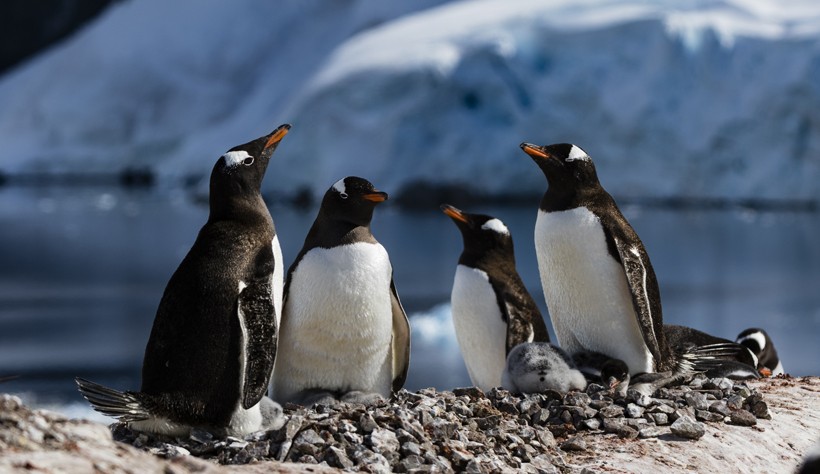
Gentoo penguin nests
?
Image credits: Rene Baars/Shutterstock
Gentoo Penguins spend a good portion of their day in feeding excursions which they carry out by diving underwater. These dives are normally short with the longest dive being a maximum of two minutes. Although they are excellent swimmers, the Gentoos usually dive down only between 3 to 20 meters. Occasionally, they may dive as deep as 70 meters.
For communication, Gentoo Penguins use a peculiar squawking vocalization. These vocal calls are normally high-pitched and males are inherently louder than females. They use vocal calls for a wide variety of reasons that can range from approving their mates to take turns for incubating the eggs. Besides the communication with their mates, Gentoo Penguins also make loud sounds when they see another penguin encroaching on their territory. In addition to these loud sounds, they make hissing and grunting sounds in order to intensify their level of threatening and drive away the encroacher.
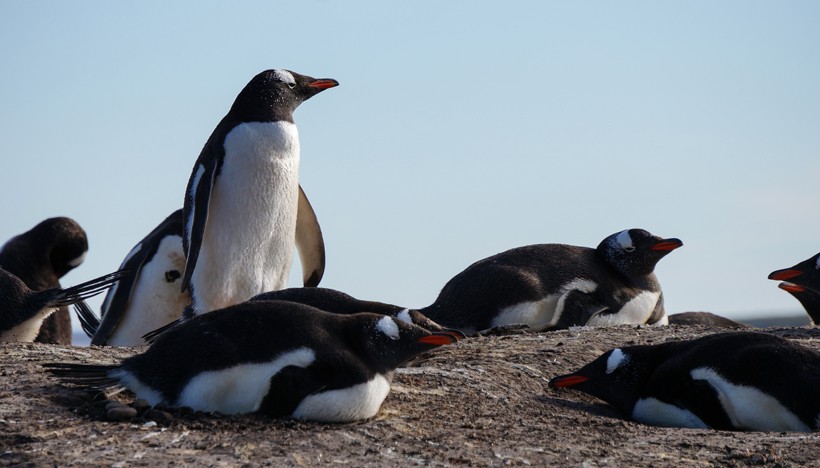
Gentoo Penguins breeding the eggs
?
Image credits: Buzz Photos/Shutterstock
The chicks of the Gentoos make a high-pitched chirping sound for communication with their parents. These young ones develop their adult call only after reaching their first molt and until then they communicate with loud chirping and modified whistling calls. Interestingly, the chicks can easily distinguish the call of their parents from among thousands of Gentoos who are nesting within the same colony.
Population and Conservation Status
The worldwide population of Gentoo Penguins is almost stable with 387,000 breeding pairs spread all across their habitat in the Antarctic peninsula, sub-Antarctic islands, Falkland Island, Kerguelen Islands and South Georgia. Among these locations, the Falkland Island is considered as one of their predominant locations with 40 % of their species inhabiting this archipelago.
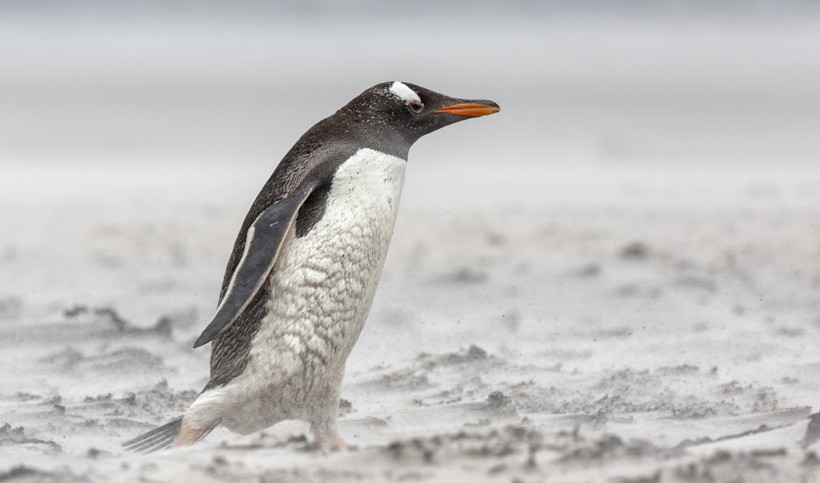
Gentoo penguin walking in a blizzard
?
Image credits: David Osborn/Shutterstock
However, some of these colonies show a rapid increase in population while others show a sharp declination. As a result of this constant fluctuation in their population size, the IUCN has listed the Gentoos in the category of ‘Near Threatened” in their Red List.
Evolutionary history
The genus Pygoscelis includes Adelie Penguins, Chinstrap Penguins and Gentoo Penguins. According to the evidence provided by their DNA, this genus might have split from some ancestral species of penguin about 38 million years ago. After this massive split, the species of Adelie penguins again split off around 19 million years ago which initiated the diversion of the chinstrap and Gentoos about 14 million years ago.
Funfacts
- The Gentoo Penguin is the third largest penguin species falling behind the King Penguin and Emperor penguin being the tallest.
- Gentoo Penguins have the capacity of reducing their heart rates from normally 80 - 100 to 20 beats/min during deep dives.
- Gentoo Penguins build their nests on the ground with pebbles, molted feathers, dry grass and other materials available in the Antarctic habitat.
- Gentoos become very territorial when it comes to their nest location. Their territory measures around 1 square meter.
- Gentoo Penguins are the fastest swimming penguins with their top speed being recorded as high as 36 km/hr.

